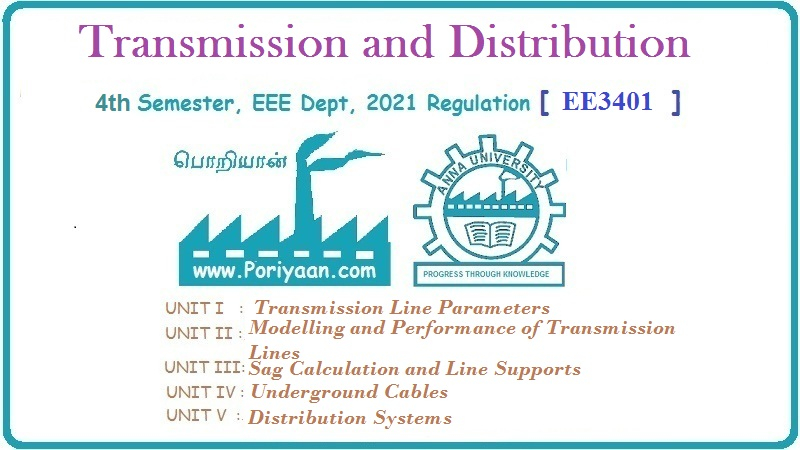Transmission and Distribution: Unit II: (a) Modelling and Performance of Transmission Lines
Surge Impedance
Surge Impedance Loading (SIL)
In power system work, the characteristic impedance is sometimes referred as surge impedance. It is defined as square root of Z/Y where Z = Series impedance of line = R + jX Y - Shunt admittance of line = G + jB
Surge Impedance
In power system work, the characteristic
impedance is sometimes referred as surge impedance. It is defined as square
root of Z/Y where
Z = Series impedance of line = R + jX
Y - Shunt admittance of line = G + jB
The term surge impedance is normally
reserved for the special case of a lossless line. For a lossless line, its
resistance and conductance are zero. Thus the characteristic impedance reduces
to √L/C which is nothing but a pure resistance in terms of dimensions. Its
value is normally 400 to 600 Ω for an overhead line while for underground cable
its value is typically between 40 to 60 Ω.
The surge impedance of the line can be
determined in terms of ZOC and ZSC where ZOC
and ZSC are impedances measured at sending end with the receiving
end open circuited and short circuited respectively.

When dealing with high frequencies or
with surges due to lightning, losses are often neglected and the surge
impedance becomes important.
1. Surge Impedance Loading (SIL)
The Surge Impedance Loading (SIL) of a
line is the power delivered by a line to a purely resistive load equal to its
surge impedance. The line is assumed to have no resistance. With such loading,
the current will be

where |VR| is the line to
line voltage at the load.
As the load is purely resistive we have,

SIL is also called natural power of the
line. Sometimes it is convenient to express the power transmitted by a line in
terms of per unit of SIL which is the ratio of the power transmitted to the
surge impedance loading.
The permissible loading of a
transmission line may be expressed as a fraction of its SIL and SIL provides a
comparison of load carrying capabilities of lines.
If surge impedance, ZC = 400 Ω
then

The above equation puts limit on the
maximum power that can be delivered which is helpful in designing the
transmission lines.
By increasing the value of receiving end
voltage, the power transmitted through long transmission line can be increased.
It can also be increased by using more than one transmission lines in parallel.
But the method is costly. Hence for increasing SIL, VR is increased
or ZC is decreased.
Review Question
1. Explain the concept of surge impedance loading.
Transmission and Distribution: Unit II: (a) Modelling and Performance of Transmission Lines : Tag: : Surge Impedance Loading (SIL) - Surge Impedance
Related Topics
Related Subjects
Transmission and Distribution
EE3401 TD 4th Semester EEE Dept | 2021 Regulation | 4th Semester EEE Dept 2021 Regulation
